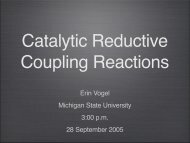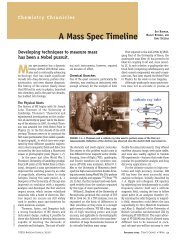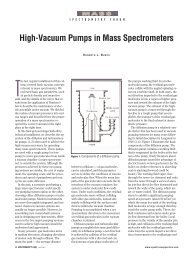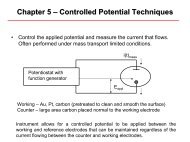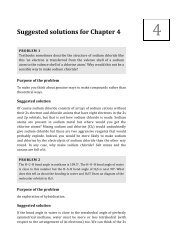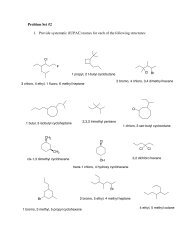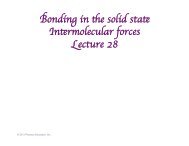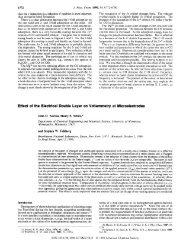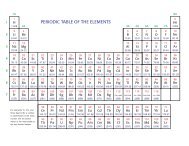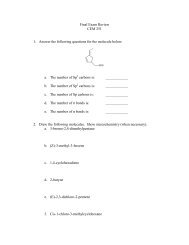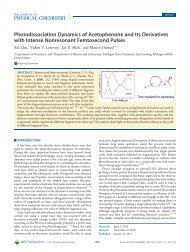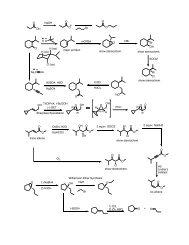Quantum control of the yield of a chemical reaction - Department of ...
Quantum control of the yield of a chemical reaction - Department of ...
Quantum control of the yield of a chemical reaction - Department of ...
Create successful ePaper yourself
Turn your PDF publications into a flip-book with our unique Google optimized e-Paper software.
4376 J. Chem. Phys., Vol. 108, No. 11, 15 March 1998 Communicationsplace with transform limited pulses, i.e., no chirp. However,chirped pulse excitation opens <strong>the</strong> possibility for introducingdifferent initial phases. Therefore, <strong>the</strong> shape and dynamics <strong>of</strong><strong>the</strong> wave packet can be <strong>control</strong>led by chirped pulses with <strong>the</strong>goal <strong>of</strong> affecting <strong>the</strong> outcome <strong>of</strong> a <strong>chemical</strong> process. 7,14,15The following experiments were carried out with ahomebuilt femtosecond laser system consisting <strong>of</strong> a collidingpulse mode-locked dye laser CPM pumped by an Ar laser.The CPM output was amplified in a pulsed dye amplifier.The amplified pulses were compressed by a two-prism,double-pass pulse compressor. The laser system producedpulses with 47 fs temporal width and with <strong>the</strong> central wavelengthat 624 nm. Typical pulse energy was 0.4 mJ 30 Hzrepetition rate, but was attenuated for <strong>the</strong> experiments to 70J. In cases where 312 nm femtosecond pulses were necessary,<strong>the</strong> 624 nm beam was frequency doubled by a KDPcrystal 0.1 mm producing 7 J pulses. The pulses were<strong>the</strong>n focused into a quartz cell containing <strong>the</strong> gaseoussample. Fluorescence signals originating from <strong>the</strong> cell werecollected along <strong>the</strong> direction perpendicular to <strong>the</strong> laser beampropagation through a 0.27 m spectrometer. The laser intensity<strong>of</strong> <strong>the</strong> 312 nm beam was continuously monitored by aphotodiode.One <strong>of</strong> <strong>the</strong> compression prisms was mounted on acomputer-<strong>control</strong>led actuator. Translation <strong>of</strong> <strong>the</strong> prism alongits bisector varied <strong>the</strong> amount <strong>of</strong> glass through which <strong>the</strong>beam propagated and permitted <strong>the</strong> introduction <strong>of</strong> linearchirp. Because <strong>the</strong> amount <strong>of</strong> chirp was computer <strong>control</strong>led,scans <strong>of</strong> signal intensity as a function <strong>of</strong> chirp could beachieved in a convenient and fast manner. Characterization<strong>of</strong> <strong>the</strong> femtosecond pulses was carried out by frequency resolvedoptical gating FROG. 18 FROG measurements in ourlaboratory provided direct measurements <strong>of</strong> <strong>the</strong> frequencycomponents <strong>of</strong> each pulse as a function <strong>of</strong> time, from which<strong>the</strong> linear chirp was determined. A continuous chirp scale asa function <strong>of</strong> prism position was compiled using <strong>the</strong> expressionfor group velocity dispersion as a function <strong>of</strong> prismposition derived by Fork et al. 19 and simplified by Salin andBrun. 20Quartz cells containing iodine, I 2 , or methylene iodide,CH 2 I 2 Aldrich 99%, were prepared on a vacuum line, andwere degassed to less than 10 6 Torr. Iodine scavengingagents sodium thiosulphate and copper were introduced in<strong>the</strong> CH 2 I 2 cell to ensure that <strong>the</strong> signal derived only fromnascent iodine. Experiments were carried out at room temperature21 °C with vapor pressures <strong>of</strong> 0.25 and 1.2 Torrfor I 2 and CH 2 I 2 , respectively.Spectral pr<strong>of</strong>iles for <strong>the</strong> 624 and 312 nm pulses measuredat zero, negative, and positive chirps were obtained inorder to experimentally confirm that <strong>the</strong> introduced chirp didnot affect <strong>the</strong> spectrum <strong>of</strong> <strong>the</strong> pulses. The intensity variations<strong>of</strong> <strong>the</strong> 624 and 312 nm pulses as a function <strong>of</strong> chirp were alsomeasured. The intensity <strong>of</strong> <strong>the</strong> fundamental remained essentiallyconstant; whereas, a small variation in <strong>the</strong> UV intensitywas observed. This variation can be understood in terms <strong>of</strong><strong>the</strong> dependence <strong>of</strong> second-harmonic generation on <strong>the</strong> peakintensity <strong>of</strong> <strong>the</strong> incoming pulses. As absolute chirp increases,<strong>the</strong> pulse width increases resulting in a reduction <strong>of</strong> peakintensity.FIG. 1. a Experimental measurement <strong>of</strong> <strong>the</strong> <strong>yield</strong> <strong>of</strong> <strong>the</strong> molecular pathwayproducing I 2 from <strong>the</strong> multiphoton dissociation <strong>of</strong> CH 2 I 2 with 624 nmlaser pulses as a function <strong>of</strong> chirp. The insert shows <strong>the</strong> relevant energeticsfor <strong>the</strong> <strong>reaction</strong>. b Same as a except for I 2 .The concerted elimination <strong>of</strong> I 2 molecules following irradiation<strong>of</strong> CH 2 I 2 is known to occur for excitation energieslarger than 9.4 eV. 21 The <strong>yield</strong> <strong>of</strong> this molecular processhas been measured to be on <strong>the</strong> order <strong>of</strong> 1%. Most o<strong>the</strong>rpathways, produce atomic iodine in its ground I and spin–orbit excited states I*. The nascent I 2 molecules are formedprimarily in <strong>the</strong> D state and have been detected followingsingle and multiphoton excitation. 22 In our laboratory, wehave explored <strong>the</strong> femtosecond dynamics <strong>of</strong> <strong>the</strong> moleculardetachment process and have found it to take place in lessthan 50 fs. 23 We have also found that o<strong>the</strong>r halogenated alkaneswith formulas CX 2 Y 2 for XH, D, F and YCl, Br,and I undergo similar molecular detachment processes. 24Detection <strong>of</strong> <strong>the</strong> molecular product is selectively carried outby dispersing <strong>the</strong> laser-induced fluorescence and collectingonly a spectral window that contains <strong>the</strong> majority <strong>of</strong> <strong>the</strong> D→A emission.Multiphoton excitation <strong>of</strong> CH 2 I 2 with 624 nm pulsesproduces <strong>the</strong> well-known I 2 D→A emission at 342 nm.Figure 1a presents variations in <strong>the</strong> relative <strong>yield</strong> <strong>of</strong> <strong>the</strong>molecular detachment pathway as a function <strong>of</strong> linear chirp.The data have been normalized to unity at zero chirp. Notethat <strong>the</strong> maximum <strong>yield</strong> is observed for 500 fs 2 and <strong>the</strong>minimum at 2400 fs 2 . We observe a factor <strong>of</strong> 2.9 in <strong>the</strong>overall change in <strong>the</strong> <strong>yield</strong> for this pathway as a function <strong>of</strong>chirp. These data are contrasted with a chirp scan obtainedunder similar conditions with <strong>the</strong> 624 nm pulses on <strong>the</strong> <strong>yield</strong>from three-photon excitation <strong>of</strong> I 2 vapor to <strong>yield</strong> D→X andD→A fluorescence between 320 and 345 nm. These re-



